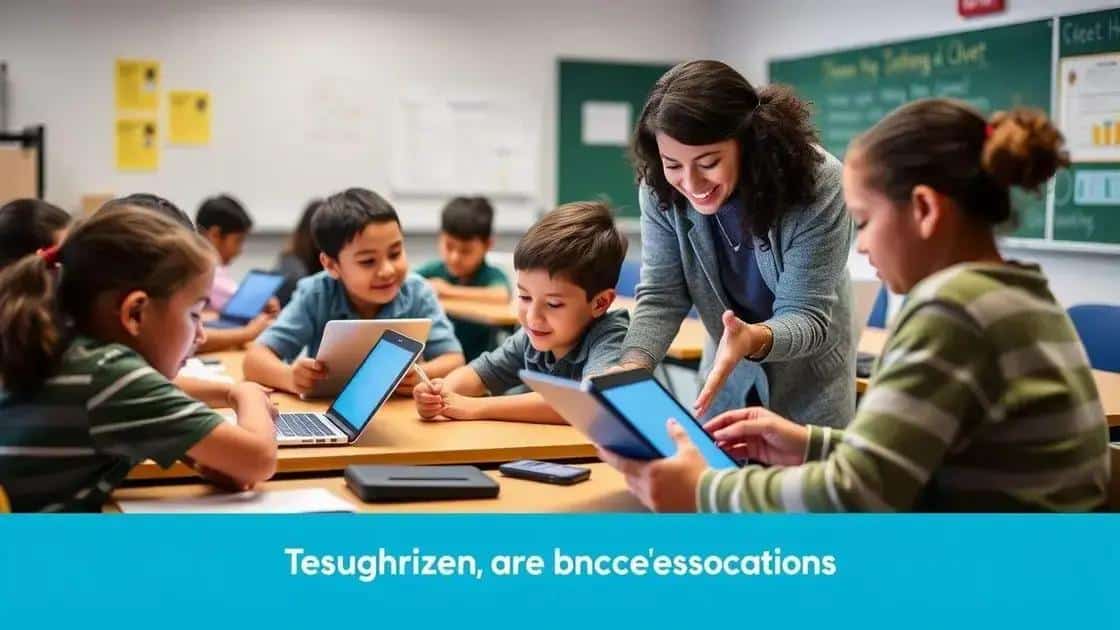Current patterns in academic success 2025 impact

Current patterns in academic success in 2025 are influenced by socio-economic factors, technology integration, and community support, highlighting the importance of adaptable learning environments for all students.
Current patterns in academic success 2025 impact how students learn and grow. But have you considered what this means for the future of education? This article dives into the evolving landscape of academic achievement and what it signifies for students today.
Understanding current academic trends
Understanding current academic trends is crucial for anyone involved in education today. These trends influence how students learn and succeed in school. They’re shaped by various factors, including technology, teaching methods, and changing societal needs.
Key Trends in Education
As we look at the landscape of education, several key trends emerge. For instance, online learning has become a significant part of education. Students can learn from anywhere, making education more accessible than ever.
- Personalized learning experiences allow students to progress at their own pace.
- Incorporating technology in classrooms helps engage students more effectively.
- Collaborative learning encourages teamwork and interaction among students.
Another important aspect is the shift towards more inclusive education. Schools are increasingly focusing on catering to diverse learning needs. This helps ensure that every student, regardless of their background or abilities, has the opportunity to succeed.
The Role of Technology in Modern Education
Technology plays a pivotal role in shaping current academic trends. Tools such as virtual reality and artificial intelligence are becoming common in classrooms, enhancing how subjects are taught. These innovations provide new ways for students to engage with the material.
Moreover, educators are finding that integrating technology effectively requires training. Teachers need the support and resources to use these tools correctly. This ensures that learning remains effective and that students benefit from the latest advancements in education.
Finally, understanding these current academic trends can help parents and students alike make informed decisions about education. Whether considering online classes or traditional schooling, being aware of what’s out there can lead to better outcomes.
Factors influencing academic success in 2025
Several factors are shaping the landscape of academic success in 2025. As the educational environment evolves, understanding these influences is key to supporting students. From resources available to students to the mental health support they receive, many elements play important roles.
Personal Motivation and Mindset
A student’s personal motivation is a critical factor for success. When students feel inspired, they tend to engage more with their studies. This can lead to higher grades and a better understanding of the material. In addition, a growth mindset, where students believe they can improve through effort, significantly impacts their academic journey.
- Setting achievable goals can enhance motivation.
- Positive reinforcement from teachers and parents encourages perseverance.
- Developing a love for learning helps students stay engaged.
Moreover, emotional well-being is crucial. Many students face stress, anxiety, or other challenges that can affect their performance. By addressing these issues, schools can create a more conducive atmosphere for learning.
Access to Resources
Access to educational resources also plays a vital role in academic success in 2025. Students with access to technology, textbooks, and tutoring services are likely to perform better. In contrast, those lacking these resources may struggle to keep up with their peers.
Furthermore, extracurricular activities provide valuable learning experiences beyond traditional academics. These activities nurture skills such as teamwork, communication, and problem-solving, all of which contribute to a well-rounded education.
Additionally, community support should not be overlooked. Schools that engage families and local organizations can offer students various ways to succeed. This collaboration can provide mentoring programs, scholarships, or workshops that enhance academic support.
The role of technology in education

The role of technology in education is becoming increasingly significant as we move toward 2025. With advancements in digital tools, classrooms are transforming into dynamic learning environments. These tools not only aid in teaching but also enhance student engagement.
Enhancing Learning Experiences
Technology helps create immersive learning experiences. For example, virtual reality allows students to explore historical sites or distant planets right from their classrooms. This kind of technology supplements traditional learning by making lessons more interactive and memorable.
- Students can access online libraries filled with resources.
- Interactive platforms allow for collaborative projects, regardless of location.
- Learning management systems help in tracking student progress efficiently.
Moreover, technology enables personalized learning. Each student has unique learning styles, and digital tools can adapt to these preferences. For instance, some students might benefit from visual aids, while others may excel with auditory materials. The flexibility offered by technology empowers students to take control of their education.
Improving Teacher Efficiency
Teachers also benefit greatly from technology. It streamlines administrative tasks, allowing educators to focus more on teaching. Automated grading systems save time, and online resources offer fresh teaching materials. When teachers have more time, they can provide individualized attention to students who need it most.
Additionally, online communication platforms facilitate better interaction with parents. Keeping families informed about their children’s academic journey can foster collaboration and support.
In summary, technology in education is reshaping how learning occurs. It creates opportunities for both students and teachers to thrive in an ever-evolving academic landscape, making education more accessible and engaging.
How socio-economic status affects outcomes
How socio-economic status affects outcomes is a complex issue in education. This factor often shapes a student’s academic journey and success. Students from higher socio-economic backgrounds tend to have more access to resources that enhance their learning.
Access to Educational Resources
Families with a higher socio-economic status can provide better educational resources. This includes access to technology, books, and tutoring services. Such support often results in better grades and overall academic performance.
- Students in wealthier households typically attend well-funded schools.
- Extracurricular activities, such as sports and arts, are more accessible.
- Families can afford private tutoring and college prep courses.
On the other hand, students from lower socio-economic backgrounds may face challenges. Limited access to these resources can hinder their ability to perform at the same level as their peers.
Impact on Mental Health
The socio-economic environment also affects students’ mental health and well-being. Stressors such as financial instability can lead to anxiety and other mental health challenges. These issues can negatively impact a student’s ability to focus and learn.
Moreover, when students feel unsupported, their motivation may decrease. This lack of encouragement can significantly impact their academic outcomes and future opportunities.
In schools that understand these challenges, programs can be implemented to provide additional support. Creating mentorship programs or offering counseling services can help bridge the gap for underserved students.
Preparing for the future of education
Preparing for the future of education involves understanding the trends and tools that will shape learning environments. As we advance, education must adapt to the changing needs of society and students.
Adapting to Technology
New technologies are at the forefront of educational transformation. Educators need to be familiar with platforms and tools that enhance learning. By incorporating technology, schools can create a more engaging experience for students. Virtual classrooms and online resources will be critical components of this new landscape.
- Using interactive apps can help students learn in fun ways.
- Online discussion boards connect students beyond their physical classrooms.
- Data analytics can help teachers track student progress effectively.
Additionally, professional development for teachers is essential. When educators have access to training, they can effectively integrate new technology in their teaching strategies.
Fostering Lifelong Learning
Another key aspect is fostering a culture of lifelong learning. Education must go beyond traditional schooling. Encouraging curiosity and exploration will motivate students to pursue knowledge even after they graduate. This mindset helps prepare them for future jobs that may not even exist today.
Furthermore, schools can promote skills such as critical thinking and creativity. These skills are becoming increasingly important in a rapidly changing world. By emphasizing these abilities, students can adapt to various challenges they may face.
Engaging with the community can provide additional support. Partnerships with local businesses and organizations can create opportunities for hands-on learning. These experiences enrich students’ education and prepare them for real-world situations.
FAQ – Frequently Asked Questions about Academic Success Factors
How does socio-economic status affect educational outcomes?
Socio-economic status influences access to resources, which can impact student performance and academic achievement.
What role does technology play in modern education?
Technology enhances learning by providing interactive tools that engage students and personalize their education experience.
Why is community support important for students?
Community support offers additional resources, mentorship, and encouragement, which can significantly contribute to a student’s success.
How can schools promote lifelong learning?
Schools can encourage curiosity and skill development, preparing students for future opportunities and a dynamic workforce.






